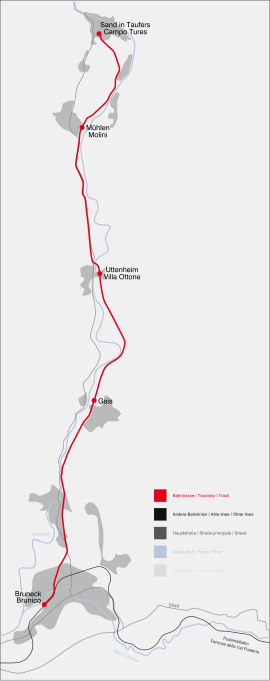History
The railroad was built by the Tirolean railway engineer Josef Riehl and from 1907 onwards 300 people were working on the construction site. The needed 800 Volt direct current for the train was produced by a small power plant in the valley using the water of the Ahr River. Until World War I the service was provided by the Austrian Südbahngesellschaft, which also ran the Brennerbahn and the Pusterer Bahn.
The cars had two motors with each 48 Kilowatt power. Because the line had only a single track, only one train could drive back and forward. Six trains made the trip from Bruneck to Taufers and back each day: the journey time was 50 minutes.
During the 1950s, there was a rapid rise in car ownership and train travel was seen to be in retreat. Track maintenance in mountain areas was costly. The final train service operated on the line on 31 January 1957. The rolling stock was sent to Merano and, in September 1958, sold for scrap.
As with many other former secondary train lines, the service today is provided by buses.

The S-train is a type of hybrid urban-suburban rail serving a metropolitan region. Some of the larger S-train systems provide service similar to rapid transit systems, while smaller ones often resemble commuter or even regional rail. They are especially common in Germany and Austria, where they are known as S-Bahn, which in the 1930s was an abbreviation of either Schnellbahn, Stadtbahn or Stadtschnellbahn, depending on the city, but they must not be confused with U-Stadtbahnen. Similar S-train systems exist also in Switzerland known as S-Bahn as well. In Denmark, they are known as S-tog[ˈesˌtsʰɔˀw], in the Czech Republic as Esko or S-lines, and northern Italy as Servizio ferroviario followed by either the word "metropolitano" or "suburbano".

The Berlin U-Bahn is a rapid transit system in Berlin, the capital city of Germany, and a major part of the city's public transport system. Together with the S-Bahn, a network of suburban train lines, and a tram network that operates mostly in the eastern parts of the city, it serves as the main means of transport in the capital.
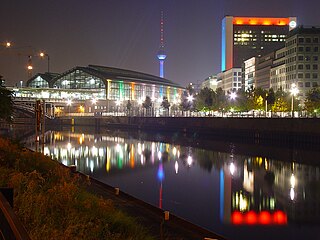
The Berlin S-Bahn[ɛs.baːn] is a rapid transit railway system in and around Berlin, the capital city of Germany. It has been in operation under this name since December 1930, having been previously called the special tariff area Berliner Stadt-, Ring- und Vorortbahnen. It complements the Berlin U-Bahn and is the link to many outer-Berlin areas, such as Berlin Brandenburg Airport. As such, the Berlin S-Bahn blends elements of a commuter rail service and a rapid transit system.

U2 is a line of the Berlin U-Bahn. The U2 line starts at Pankow S-Bahn station, runs through the eastern city centre (Alexanderplatz) to Potsdamer Platz, the western city centre and finally to the Ruhleben terminal station.

The Luzern–Stans–Engelberg railway line is a Swiss narrow gauge rack railway that connects Luzern, via Hergiswil and Stans, to the resort of Engelberg. The line was built by the Stansstad–Engelberg Railway, which became the Luzern–Stans–Engelberg Railway when the line was extended to Luzern.

The Copenhagen S-train is the S-train of Copenhagen, Denmark. It is a hybrid urban-suburban rail serving the Copenhagen urban area, with the notable exception of Amager. The average distance between stations is 2.0 km, shorter in the city core and inner boroughs, longer at the end of lines that serve suburbs. Of the 86 stations, 32 are located within the central ticket fare zones, 1 and 2. The S-tog is analogous to S-Bahn systems in Germany, and is a separate system from the Copenhagen Metro, which operates in the city centre, Frederiksberg, and Amager.
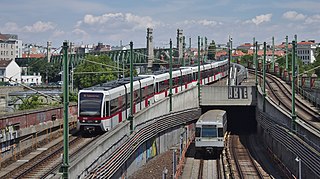
The Vienna U-Bahn, where U-Bahn is an abbreviation of the German term Untergrundbahn, is a rapid transit system serving Vienna, Austria. With the September 2017 opening of the 4.6 kilometers (2.9 mi), five-station extension of the U1 line, the five-line U-Bahn network consists of 83.1 kilometers (51.6 mi) of route, serving 109 stations. It is the backbone of one of the best performing public transport systems worldwide according to UITP in June 2009. More than 1.3 million passengers rode the Vienna U-Bahn every day in 2009, and 567.6 million passengers used the U-Bahn in 2011, which declined to 428.8 million passengers in 2013. The network is undergoing expansion and rolling stock renewal. Since 1969, 200 million euros have been invested annually in the extension of the Vienna U-Bahn.

The Brig-Visp-Zermatt-Bahn (BVZ) – officially known between 1991 and 2002 as the BVZ Zermatt-Bahn – is a metre gauge railway in the Canton of Valais, Switzerland. Its 44 kilometre long line links the communities of Brig and Visp in the Rhone Valley with Täsch and the car free holiday resort of Zermatt in the Mattertal. The BVZ also forms part of the much travelled and admired route of the Glacier Express between St. Moritz and Zermatt. Opened in 1891 as the Visp-Zermatt-Bahn (VZ), the BVZ merged on 1 January 2003 with the Furka Oberalp Bahn (FO) to form the Matterhorn Gotthard Bahn (MGB).

The Hamburg S-Bahn is a suburban commuter railway network in the Hamburg Metropolitan Region. Together, the S-Bahn, the Hamburg U-Bahn, the AKN railway and the regional railway form the backbone of railway public transport in the city and the surrounding area. The network has operated since 1907 as a commuter rail system, under the direction of the state railway, and is a member of the Hamburger Verkehrsverbund. There are six lines, serving 68 stations, on 147 kilometres (91 mi) of route. On an average working day the S-Bahn transports about 590,000 passengers; in 2010 about 221 million people used the S-Bahn.

The Hamburg U-Bahn is a rapid transit system serving the cities of Hamburg, Norderstedt and Ahrensburg in Germany. Although technically an underground, most of the system's track length is above ground. The network is interconnected with the city's S-Bahn system, which also has underground sections. It is operated by Hamburger Hochbahn within the Hamburger Verkehrsverbund (HVV). It was opened in February 1912, and comprises four lines serving 93 stations, with a route length of 106.4 kilometres (66.1 mi) in 2019.
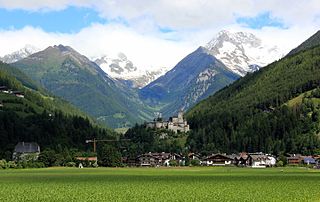
Sand in Taufers is a comune mercato in South Tyrol in northern Italy.

The Rhine-Main S-Bahn system is an integrated rapid transit and commuter train system for the Frankfurt/Rhine-Main region, which includes the cities Frankfurt am Main, Wiesbaden, Mainz, Offenbach am Main, Hanau and Darmstadt. The network comprises nine S-Bahn lines, eight of which currently travel through the cornerstone of the system, a tunnel through central Frankfurt. The first section of this tunnel was opened on May 28, 1978. Further tunnel sections were opened in 1983 and 1990, before its completion in 1992. The system belongs to the Rhein-Main-Verkehrsverbund (RMV) and is operated by DB Regio, a subsidiary of Deutsche Bahn.

The Ritten Railway is an electric light railway which originally connected Bolzano with the Ritten plateau and today continues to operate on the plateau, connecting the villages located there.

The Frankfurt am Main tramway network is a network of tramways forming a major part of the public transport system in Frankfurt am Main, a city in the federal state of Hesse, Germany.
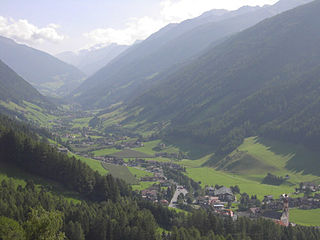
The Tauferer Ahrntal denotes the valley of the Ahr River, a tributary valley of the Puster Valley in South Tyrol, Italy. It is commonly divided into the Tauferer Tal, stretching from the confluence with the Rienz River near Bruneck up to Sand in Taufers, and the Ahrntal proper up to the source in Prettau.

The Munich–Rosenheim railway is a 65 kilometre-long double-track main line of the German railways. It connects Munich Hauptbahnhof with Rosenheim station, where it connects with the Rosenheim–Salzburg railway, which connects with the line to Vienna at Salzburg, and the line to Kufstein, which continues to Innsbruck and the Brenner line to Italy. The line is part of the "Main line for Europe", connecting Paris with Bratislava and Budapest and the almost identical line 17 of Trans-European Transport Networks (TEN-T). It is part of the line 1 of TEN-T. It is electrified at 15 kV, 16.7 Hz. It was opened between Munich and Rosenheim in 1871.
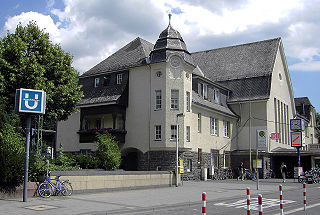
Bonn-Bad Godesberg station is on the Left Rhine line in the Bonn district of Bad Godesberg in the German state of North Rhine-Westphalia.

S-Bahn Mitteldeutschland represents an enlargement of the previous Leipzig-Halle S-Bahn. It is an electric rail public transit system operating in the metropolitan area of Leipzig-Halle, Germany. This S-Bahn network had developed from two separate S-Bahn networks of Halle (Saale) and Leipzig, which were established separately in 1969 and then linked in 2004. With the opening of the Leipzig City Tunnel on 15 December 2013 as a new artery, the network was extended to the federal states of Thuringia and Brandenburg. The locomotive-hauled double-decker trains had been replaced by electric multiple unit Bombardier Talent 2 trains.

The Sihltal railway line is a railway line in the Swiss canton of Zürich, which connects the city of Zürich with the communities of the Sihl Valley. Passenger service on the line now forms part of the Zürich S-Bahn, branded as that network's service S4, and is part of the Zürcher Verkehrsverbund (ZVV) zone-based fare network.

The Düren–Neuss railway is a line in the German state of North Rhine-Westphalia. The non-electrified main line originally ran from Düren to Neuss, but the Düren–Bedburg section has been closed and dismantled.
